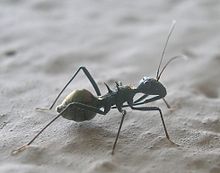- Alydidae
-
Alydidae 
Alydus calcaratus Scientific classification Kingdom: Animalia Phylum: Arthropoda Class: Insecta Order: Hemiptera Suborder: Heteroptera Infraorder: Pentatomomorpha Superfamily: Coreoidea Family: Alydidae
Amyot & Serville, 1843Subfamilies Alydinae
Micrelytrinae
and see textSynonyms Coriscidae Stichel, 1925
Alydidae, commonly known as broad-headed bugs, is a family of true bugs very similar to the closely related Coreidae (leaf-footed bugs and relatives). There are about 40 genera with 250 species altogether. Distributed in the temperate and warmer regions of the Earth, most are tropical and subtropical animals; for example Europe has a mere 10 species, and only 2 of these occur outside the Mediterranean region.
Contents
Description
Broad-headed bugs are up to 10–12 millimetres (0.4–0.5 in) long, and have slender bodies. Some have long and very thin legs. The most notable characteristics of the family are that the head is broad, often similar in length and width to the pronotum and the scutellum, and that the last antennal segments are elongated and curved. The compound eyes are globular and protruding, and they also have ocelli. The femora of the hindlegs bear several strong spines; the tarsus has three segments. Most species have well-developed hemielytra (forewings), allowing them to fly well, but in some the hemielytra are vestigial. The membranous part of the hemielytra has several long veins.
Alydidae are generally of dusky or blackish coloration. The upperside of the abdomen is usually bright orange-red. this color patch is normally not visible as it is covered by the wings; it can be exposed, perhaps to warn would-be predators of these animals' noxiousness: They frequently have scent glands that produce a stink considered to be worse than that of true stink bugs (Pentatomidae). The stink is said to smell similar to a bad case of halitosis.
The larvae and adults, which sometimes have reduced wings, of some species such as Dulichius inflatus and Hyalymenus spp. are ant mimics and live in ant nests.[1]
Ecology
These bugs mainly inhabit fairly arid and sandy habitat, like seashores, heathland, steppe and savannas. Their main food is seeds, which they pierce with their proboscis to drink the nutritious fluids contained within. Some are economically significant pests, for example Leptocorisa oratorius on rice.
Systematics
Three major lineages of broad-headed bugs are known. Two are generally accepted as subfamilies, the third is either placed as a tribe Leptocorisini in the Microelytrinae,[2] or treated as a third subfamily Leptocorinae.[3]
Selected genera
- Alydus
- Camptopus
- Heegeria
- Leptocorisa
- Megalotomus
- Micrelytra
- Nariscus
- Nemausus
- Neomegalotomus
- Tenosius
References
- ^ Oliveira PO (1985). "On the mimetic association between nymphs of Hyalymenus spp. (Hemiptera: Alydidae) and ants". Zoological Journal of the Linnean Society 83 (4): 371–384. doi:10.1111/j.1096-3642.1985.tb01182.x.
- ^ Carl W. Schaefer (1999). "The higher classification of the Alydidae (Hemiptera: Heteroptera)". Proceedings of the Entomological Society of Washington 101 (1): 94–98.
- ^ I. Ahmad (1965). "The Leptocorisinae (Heteroptera: Alydidae) of the world". Bulletin of the British Museum of Natural History 5 (Supplement): 1–156.
Categories:- Insect families
- Pentatomomorpha
Wikimedia Foundation. 2010.

